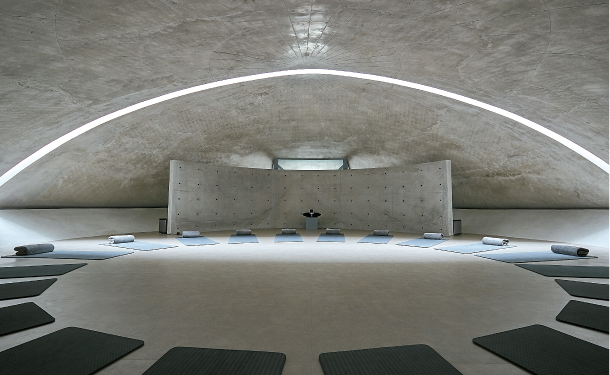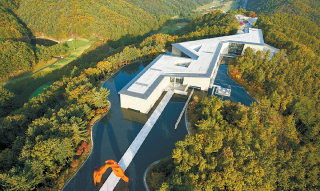Museum SAN quietly opens its own meditative space : The aesthetic wonder of the Gangwon space gets more geometric

Six years after opening its doors, the museum added its new Meditation Hall this winter, inviting visitors to rest their minds while they enjoy what’s on display.
Recently named one of the 100 Must-Visit Tourist Spots of Korea for the third year in a row by the Korea Tourism Organization, the museum saw 170,000 visitors last year alone. And while it may seem out of the way for those in the capital, especially for those who do not drive, the museum is surprisingly accessible by train or bus. The Wonju City Bus Tour, which operates 10 buses every day, stops at Wonju train station, the terminal and the museum. The museum also operates its own shuttle buses.

The new Meditation Hall, top, provides visitors the cozy feeling of being inside a cave with its grey color and dome-shaped structure. The new hall was designed by Japanese architect Tadao Ando, who also designed the Museum SAN building, above. [MUSEUM SAN]
Ardent fans of Museum SAN know that the paintings and sculptures aren’t the only artworks on display. The building itself, the Stone Garden, the Water Garden and every little detail about the space provide visitors with the ultimate cultural experience, and is driven by the museum’s slogan “Disconnect to connect.”
The Meditation Hall is no exception. It officially opened New Year’s Day, and although the museum had not advertised the new facility, it’s already beginning to build a steady fan base among visitors looking for some peace and quiet. Japanese architect Tadao Ando - one of the world’s most famous contemporary architects - designed the new structure and created it to fit in with the original Museum SAN building, which he also created.
Taking up some 132 square meters (1,420 square feet), the dome-shaped structure sits on the northern corner of the museum’s grounds, next to the Stone Garden. The Stone Garden initially had nine stone mounds shaped like miniature hills and covered with silver-hued stones, resembling the ancient royal tombs commonly found around Gyeongju, North Gyeongsang. The new Meditation Hall looks just like one of the mounds, with an open slit that goes across the middle.
Stepping inside the Meditation Hall, the slit functions as a thin window to let natural light in to the grey hall - a signature of the Japanese architect. The light let in by the arch-shaped window, which changes its angle according to the time of day, is reminiscent of Ando’s famed Church of Light building located in Osaka, Japan. The exposed concrete of the inner grey walls works with the dome-shaped ceiling to create a cozy atmosphere, while also adding a touch of sublimity with its resemblance to a quiet cave.
As the main source of the light inside the hall depends on the sunshine, the hall takes on a different ambience at different times of the day. According to the museum, the best time of the day to enjoy the stark contrast of light and dark is at around 2 p.m., when the sun directly shines down on the window. The museum explains Ando’s design is intended for “the minds of the people, who meditate in a space that follows the movement of the sun.”
“Ando meant for the Meditation Hall to be a place of thoughts, of nothingness,” explained Choi Yong-june, the head curator of the museum. “He has always been interested in the idea of resting and meditating, and hoped to make a space for the visitors [of the museum to relax]. He referred to the Stone Garden as ‘the space of nothingness,’ that leads up to the new Meditation Hall.”
The idea of a Meditation Hall began when the director of the museum, Oh Kwang-su, visited France a few years ago. He dropped by a small and quiet chapel, which, at the time, had almost no visitors other than himself. The peaceful atmosphere gave him time to sit in silence, eventually birthing the idea for a meditation hall at his museum.
The museum currently offers regular sessions every 30 minutes from 10:45 a.m. to 5:15 p.m., taking in 20 people at a time. On weekdays, there are regular meditation programs offered by the museum, and on weekends, various guests from different cultural fields help visitors engage on a journey to learn more about one’s self. Guest lecturers from the past have included artists, psychology professors, musicians and yoga teachers. Reservations can be made online.
Beyond Simplicity
Museum SAN is also famous for being a well-established example of a conglomerate-built art museum. Built by Hansol Group in 2013, the museum offers both special exhibitions that are renewed every few months, as well as displaying artworks owned by the museum.
Kicking off this year’s first special exhibition is “Geometry, Beyond Simplicity,” which started on March 22. The exhibition takes place in Cheongjo Gallery 1 and 2, and features some 40 works by 20 artists who have each used the idea of geometry to communicate with viewers in the simplest of forms. The exhibit is divided into three themes: Interpreting the given form into simple geometrical shapes; expressing abstract ideas with geometry; and how geometrical forms can interact with surrounding spaces in the real world.
While the first section takes place inside Cheongjo Gallery 1 and the second part inside Cheongjo Gallery 2, the works in the third section are displayed in different parts of the museum for visitors to actually witness how the installations blend into the space.
While walking from the museum’s entrance to Cheongjo Gallery 1, visitors walk along “Interspace” (2019) by Kang Eun-hye, a site-specific installation work in which green strings are attached from either ends of the museum ceiling to create a visual diversion of space. Bahk Seon-ghi’s “An aggregation 20190306” (2019), made up of acrylic mirrors hanging from the ceiling that reflect the sunlight, is placed outside of entrance to Cheongjo Gallery 1.
Since most of the works are based on simplifying ideas and forms, the galleries take on a calm and understated ambience that allows visitors to understand the different dimensions. While at first it’s enough to just admire the simple beauty of the works, a deeper appreciation allows people to see how the most concise forms are able to reach through to the largest of crowds. “Perspective Dimensions” (2019) by Han Kyung-woo, a work in the first section of the exhibit titled “Geometry, from Simplicity,” is one such example. While the white installation looks like a painting of two cubes on the wall, viewing it from the side reveals its true three-dimensional identity: one protruded and one concave.
“It creates a visual illusion by playing with the way our brain analyzes our visual field,” Choi Jin-ha, the curator of the exhibition, explained. “We wanted to target the young audiences who come to the museum, and chose a very modern and dynamic theme this time. And so many of the artists are also very young, too. The exhibition looks at how the geometric works interact with the geometry of the space that contains it.”
Other works such as Anna Han’s “Exit #110(2)” (2011), Lee Hee-joon’s “A shape of taste” series (2018), Hong Seung-hye’s “On & Off” (2019) and Lee Kang-wook’s “Untitled” series also on display.
In Cheongjo Gallery 3 is “Looking into Korean Art V: Abstract Painting,” an exhibition featuring 30 paintings owned by the museum. The fifth exhibition of the museum collection, curators chose works that go well with the idea of “simple geometry,” such as Kim Whanki’s famed “Untitled” (1971) red-and-blue painting, as well as works by Rhee Seundja, Ham Dae-jung and Chung Kyu. The exhibit will be on display until March 1, 2020.
BY YOON SO-YEON [yoon.soyeon@joongang.co.kr]
Tickets to the art exhibitions cost 18,000 won ($15.50) for adults and 10,000 won for minors. A ticket that allows entrance to the museum and the James Turrell Hall costs 28,000 won for adults and 18,000 won for children. Tickets to the museum and the Meditation Hall are 28,000 won each. Entrance to all three facilities costs 38,000 won. Children are not allowed into the Meditation Hall. For more information, call (033) 730-9000 or visit www.museumsan.org










with the Korea JoongAng Daily
To write comments, please log in to one of the accounts.
Standards Board Policy (0/250자)